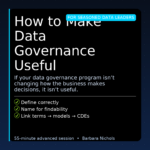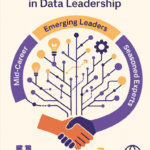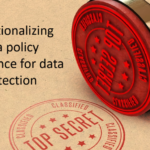
Aligning Organizational Leadership
Abstract: Getting support for data initiatives is not easy. Being successful requires that CDOs understand the environment and the roles that operate within it. Most importantly, CDOs need to reach out and develop trusted relationships with key leaders. This article describes critical organizational relationships and offers CDOs discrete advice for securing organizational support for data initiatives:
- Who are critical leaders?
- How do they affect CDOs?
- How should CDOs work with other organizational leaders?
Introduction
Organizational alignment is an important concept for leaders to consider. This is especially true in the current fast-paced, complex, and constantly changing working world, and nothing guarantees mission failure more than a lack of alignment in a senior leadership team. No responsible leadership team wants to be misaligned, but it happens all the time and can be very damaging to the success of an organization. When alignment doesn’t exist, then entire organization feels the pain, which in turn helps ensure that employees are not connected to a shared sense of purpose. Conversely, when alignment does exist, employees invest more of their time, talents and energy into meeting or exceeding organizational goals.
According to the Massachusetts Institute of Technology’s (MIT) Sloan Business School, many companies are responding to an increasingly digital environment by adding roles that are digitally focused or have a digital orientation (Allega et al, 2017). The list of digital roles and functions is extensive and growing. There are now digital strategists, chief digital officers, digital engagement managers, digital finance managers, digital marketing managers, and digital supply chain managers, and a host of other similarly named roles. The chief data officer is one of these new roles.
However, new roles mean that the likelihood of misalignment and conflict increase; therefore, it is critical that organizations recognize this risk and normalize these roles as soon as possible. Saying this is easy, though, and preparing for a digital future is no easy task. It means developing digital capabilities, in which an organization’s activities, people, culture, and structure are synchronized and aligned toward a set of common and ratified organizational goals. In fact, many of the functions that a CDO performs are functions that were historically performed by other experts like the CIO. Other functions—like data analytics—are relatively new and which role is responsible for their performance remains unsettled and unclear. Still, other functions and interfaces should be sharpened and clarified. For example, CISOs are responsible for defining and verifying that security controls are implemented according to prescribed IT standards. So, how do CISOs know what standards should be applied? The data. And what role is responsible for setting the data protection requirements for each data asset? The CDO. In this case, the CDO and CISO should establish a protocol and recordkeeping systems to inform the CISO what they should do to effectively protect data.
The classic work by John Kotter, Organizational Dynamics: Diagnosis and Intervention (1978), identifies six structural areas that leaders should concentrate on in order to ensure organizational alignment.
- Education and Communication
- Participation and Involvement
- Facilitation and Support
- Negotiation and Agreement
- Manipulation and Co-Optation
- Explicit and Implicit Coercion
Though Kotter’s work is considered by many to be practical, the methodology can seem overwhelming. Instead of following Kotter’s methodology, we advocate focusing on some key relationships that that the CDO should establish, grow, and mature. These are relationships that directly affect different aspects of the CDOs charter and are relationships that can easily derail progress if they go unattended or sour. The following section offers practical advice for establishing positive and productive relationships with the following executives/bodies of government.
- Chief Information Officer
- Chief Information Security Officer
- Privacy Officer
- Chief Archivist
- General Council
- The Legislature (Assembly or Council)
- Chief Executive (Governor, City Manager)
- Chief Information Officer (CIO)
Most would agree that CIOs are stretched too thin (Griffith, 2013). Organizations expect CIOs to manage internal business systems, migrate to the cloud, introduce new innovations, ensure that data secure, and provide 24×7 support to users who access organizational data around the world. Ray Wang, Principal Analyst & CEO of Constellation Research Group outlines four personas of the next generation CIO:
- Chief “Infrastructure” Officer (Keeping the Lights On): and managing existing systems
- Chief “Integration” Officer: Bringing together internal and external data and systems
- Chief “Intelligence” Officer: Fostering business intelligence and getting the right data to the right people
- Chief “Innovation” Officer: Looking for disruptive technologies to drive innovation
What is clear is that more and more CIO resources are focused on technology and the complexity that accompanies it. But what is missing here? Despite its name, chief information officers pay little to no attention to data, the thing that fuels today’s organizations economies. That can look like you are adding more to the already strapped CIO’s plate. Far from it.
What is clear is that more and more CIO resources are focused on technology and the complexity that accompanies it. But what is missing here? Despite its name, chief information officers pay little to no attention to data, the thing that fuels today’s organizations economies. That can look like you are adding more to the already strapped CIO’s plate. Far from it.
Infrastructure (Keeping the Lights On): Every day, CIOs work to maintain their systems and seem to have no money or time to do anything else except “keep the lights on. For these organizations, understanding where data resides helps dictate where organizational priorities should be. One way to help establish these priorities is to determine where the most important data is. For example, as its name implies, critical systems contain important data, and the sooner organizations understand what data those systems hold, and how the organization processes that data, the sooner organizations can identify the criticality of that data. After organizations review their main systems, they can begin to sift through the lesser important systems to help identify where maintenance can be reduced, migrated to other storage mechanisms, or potentially deleted all together. Reducing what is needed to “keep the lights on” can yield small wins with big results.
Integration: CIOs work on project-based priorities and drive results when projects are complete. Their world is driven by the project tempo with everything having a beginning, a middle, and an end. The notion of having ongoing activities beyond manning a help desk is rare. Sustained operations are more common on the business side of the organization, where the organization delivers services to a wide range of customers. Here, CDOs can help CIOs with insights on data and appropriate adjustments to projects involving data is as important as a CDO who can manage projects to completion. So here, the CDO provides insights and suggests adjustments to ongoing projects to enhance the delivery of new and improved capabilities. Being able to assist CIOs with bringing program teams together, understanding the needs, helping to clarify questions around data, and integrating systems will be the most critical achievement CDOs can undertake.
Intelligence: CIOs shift from being project-based to performing their work with a more enterprise perspective. CIOs have a long, jaded history of creating massive projects, costing organizations huge amounts of money. They buy huge amount of equipment, hire teams of consultants, make promises that are questionable, at best. Many operate as though they carte blanche trying to change years of business process with the latest technology promises. These efforts are rarely successful as the other demands quickly eclipse the mammoth effort and causing financial and schedule catastrophe. As with “Keeping the Lights On”, understanding the top organizational priorities, projects, stakeholders, and systems should always be CDOs’ starting point, and when CDOs begin their work, they should take a tip from a famous television character, Angus “Mac” MacGyver.
In contrast to CIOs, CDOs are still new and are not resourced at an appropriate level. But this should not depress anyone; instead, it should invigorate CDOs. Not having enough resources means that CDOs should be prepared to work with paper clips, duct tape, and string. Instead of creating enormous programs, think about the 3 S’s: Start by starting, show value, and set a reasonable pace for your work. Come out with too many ideas and your organization won’t be able to get everything implemented. Get too many things started in the first project, and people will want the same (and better) results, whether or not you are able to get additional budget for it. Pick up the pieces you can do with spreadsheets and basic databases. “MacGyver” it, so to speak—paper clips and duct tape can take you far.
Innovation: CIOs take it one step further and allow you a lot more leeway. As with “Intelligence” CIOs, leeway doesn’t mean that CDOs have “open highway.” So, be sure to run, but run with good ideas; pick projects that have recognizable, urgent and narrow issues to solve However, always remember to start by starting, show value (regularly), and set a reasonable pace for your work.
Regardless of which CIO type you work with, implementation remains a part of the CDO success plan. As they work on projects with various technical teams across the organization, CDOs will be exposed to people inside and outside the organization. Working with others offers great opportunities for talking about data innovation and how the CDO is instrumental in this area. In this way, innovation means staying ahead of the practical tasks that need completion. So, when this opportunity is available, take it. Mark up and highlight key work areas from this book and create an elevator pitch. Having a recurring message about data and innovation related to data, helps sell the idea. Gaining access to more and varied teams enables you to spread that message to more varied parts of the organization. Keeping an implementation mindset allows you to show practical work to the more operationally focused portions of an organization. Being ready to talk about how data innovation might affect and enable their team helps those teams see you as a strategic partner.
Chief Information Security Officer (CISO)
CISOs and CDOs share a common trait; the data. Where the CDO describes the data, its sensitivity, and the rules for its usage, CISOs are responsible for making sure that the organization follows the rules and that the systems comply with specific settings and configuration. In this way, CDOs inform CISOs what they should do. In this way, CDOs and CISOs are responsible for data regardless of its format, digital or analog. Continuing this comparison, CISOs are similar to CDOs in one crucial aspect; their role should, but often doesn’t, manage everything. Just as data is EVERYTHING, so is security. Often is the case, that until something really bad happens, CISOs are dragged from meeting to meeting, yelling at the top of their lungs that the sky is falling and it’s going to hurt. In some ways, the CDO is also a more recent hire and still has a lot of ground to gain in terms of getting the budget and the understanding of their real value to the organization.
Where these folks are available, learn from them. Ultimately, they can be a strong ally, but they’ll also be your future tight partner. You will understand what data is out there, how to maintain and utilize it and your CISO will be the one to properly protect it. Doing that correct benefits the organization and allows you both to properly complete (and keep) your jobs. On a more strategic level, the CISO also has to view the organization across its entirety—the people, process, platforms and policies. They have a great potential to be a likeminded sounding board for needed development across it all.
Chief Analytic Officer (CAO)
When a data analytics program exists and has matured to include elements of several parts of an organization, Chief Analytic Officers are often assigned to manage current analytics programs and development of additional measurements for organizational use and review. The CAO is normally a more technical person with a background in statistics, mathematics or engineering. They understand the algorithms used to derive insight at a deeper level than a CDO. It is important for this role to be able to communicate how the data is used and under what assumptions, whereas the CDO is critical in supporting what is possible through governance efforts around metadata and quality.
CAOs and CDOs should work closely together. Analytic conclusions are only as good as the quality of data supporting them. The CAO must communicate data needs to the CDO and the CDO must work on the governance and its associated business processes and structures to ensure timely high-quality data is available for analysis. The CDO and CAO should work together to evangelize the value proposition for data. Data governance costs money and the CAO should be able to work with the CDO to do a cost benefit analysis demonstrating the value of these efforts.
There are cases where CAOs do not exist in an organization, but their function must. The CAO role can be split between a CDO and a data scientist or group of data scientists. The CAO role can be part of the responsibilities of the CDO. Whatever the configuration the duties of advocacy of the needs, cost and benefits of analysis and the management of the resulting strategy need to be addressed.
Privacy Officer (PO)
Similar to CISOs and CDOs, Privacy Officers (PO) are newer roles within typically health care organizations. They are responsible for overseeing the development, implementation, maintenance of, and adherence to privacy policies and procedures regarding the safe use and handling of protected health information (PHI) in compliance with federal and state HIPAA regulations. As opposed to the CISO and CDO role, POs are mandated by statute and typically fall into a role within the compliance portion of an organization. While many expect Legal to lead in this area, in fact, Compliance, is responsible for making sure that people, processes, platforms and policies track with the law, usually as that law is applied in audits. POs are the folks who comb through audit reports and define changes the organization needs to do to with the results of audits. Compliance is also the area that is expected to operate efficiently and run like clockwork when there are no audits happening. Consequently, studying compliance and understanding what needs they have and where they currently pull data from can help you understand how easily accessible the data is. Doing this also gives you an opportunity to see where data could be incrementally improved so that compliance could become even more efficient and detect problems even earlier. That’s a win for everyone.
Compliance is different in one very important way: when organizations are out of compliance, regulatory agencies can assign fines and other penalties, and because of this unique distinction, organizations tend to respond and provide sufficient funding to stay in compliance. Though it may seem obvious, it is always easier to get something done when there is money, priority, and commitment around it. So, use compliance to your advantage. Tout it. Use it to your advantage to secure project funding. Exploit it to your advantage to learn more about the systems that are regularly audited—RUN with it—recognized, urgent and narrow focused.
Chief Archivist (CA)
Even though information science and library science has been around for thousands of years (dating back to the 3rd century, BC), the CA doesn’t receive much funding. In this way, the CDO and the CA or close cousins (unless archiving/history is your business, or your organization has been sued a bunch of times for not having something required by law) and unless you really work your pitch, talking about your job at parties puts people to sleep. Archivists know where EVERYTHING is and they are typically at organizations for the long term, so they also know where all the bodies are buried, literally and figuratively. Organizational knowledge is critical to not only know where things are but also to make sure you understand what will blow up if you try to move them. Having a mapping partner in this regard is critical because latent bombs are just waiting for you to dig them up. Many people assume archivists want to keep everything, but that is not really the case. They try to understand the value a piece of information has and then properly catalogue it for future use. Don’t let the myths and legends about these folks hamper your thoughts on working with them. They are valuable assets and when it comes to cataloguing and methods for organizing, they’ll be irreplaceable.
General Counsel (GC)
Mahatma Gandhi, Nelson Mandela, Abraham Lincoln are three men who invoke the ideas of courage, integrity and social justice. All three of these men were attorneys; however, when one hears of lawyers today, people rarely associate integrity, courage, and justice with them. Instead people use words like liar, shyster, and sometimes even sleazy to describe the profession. Quick, better call Saul.
Perhaps the most famous quote is from, William Shakespeare who wrote, “First kill all the lawyers”. What is the great bard saying about lawyers? Well, to the surprise of many, this quote means something entirely different than many would believe. In a brief 1990 New York Times article (Citation), AuthorName notes the line was said by Dick the Butcher who wanted to disrupt the law and become king. In reality, Shakespeare’s character believed that lawyers were actually just and too law abiding for the menacing intent at hand, and today, the world has not changed that much. Lawyers are frequently mistaken for bad people with bad intentions simply because they raise issues and tell us things we don’t want to hear and hearing the truth can be hard sometimes.
The world of technology and data has grown exponentially both in bytes and bits, but also in terms of complexity. Today, we create and process more data than ever before, so it should not be surprising that more issues can arise than ever before. This includes legal issues.
As described, data is neutral. it is a collection of stored facts that can describe good things or bad things. Data describes our entire experience, not just the lifecycle actions, but also the interaction points those lifecycle actions have for an organization. When data is created, the creator(s) start the process of that data’s lifecycle but may not be the only ones affecting that data. If data is created as part of a system, then who owns that data—the person whose data is being entered, e.g. a citizen, or the agency that is storing that data or the agency that may be managing the systems that data is being stored?
The intersection of actors, the client, and the lifecycle state is where legal analysis begins. Now multiply that by the number of possibilities for each, including the transition points of ownership and other activities. The challenge for attorneys and legal strategy exists not only in all the possibilities, but also in the fact that data is rarely static—either in systems or in everyday use. In turn, the legal analysis can quickly shift depending on what is happening at the time and what came first, as well as what the possibilities might be in the future. Most attorneys are trained to detail the outcomes and risks associated with each legal question. However, data presents new problems for lawyers: it all but impossible for lawyers to list the combinatorial possibilities, legal issues, risks, and related results.
So, when you approach your General Counsel and ask, “What are the risks?” Or “What are the legal ramifications of storing data?” Or “How should I set retention periods?” Or “What would happen if we sold our data?” All they may hear is a freight train bearing down on them, whistle blowing, and headlights streaming into their face. For attorneys, this is a terrifying predicament, and you should expect lawyers to recommend the most conservative way forward. Most likely, this won’t help you out of your predicament. There are simply too many possible options and many of them have monstrous implications.
On the other hand, if CDOs operate from a strategic perspective and include counsel from the outset, GC can help the CDO gain traction, solving small but important problems out of the gate. However, if CDOs take on too much too soon, counsel will be caught off guard and try to reign in what they perceive to be the riskiest work. So, the key to working with GC is to engage early and often. Spend time with your counsel. Don’t relegate decision making to Legal but make them part of the solution. Help them get have some ownership of the solutions, and GC will help the CDO begin to gain traction, early. A good tip for identifying work that would bode well for working with GC would be the “RUN” principle; identify work that is recognized, urgent, and narrowly focused. The combination of each of these attributes will help counsel limit exposure and reduce risk going forward.
The Legislature (Assembly or Council)
As CDO, one of your main goals is to educate people on the importance of data, its governance, and the tools, processes and strategies to leverage data as a strategic asset. Not surprisingly, this effort will pay dividends if your audience accepts your message. This message has to be tailored to the particular group you are trying to convince. So, CDOs should give special thought and attention to how the communicate with the legislature. This is easier said than done because politics immediately come into play. Nowhere are there more pronounced differences than in the legislature. Different political parties. Different constituencies, different priorities, and a stream of outside influence makes working with the legislature very tricky, indeed.
Quite often the chief executive will ban but a few people from talking to a legislature. Normally the CDO is under the State CIO who supports and guides agency CIOs. Due to the high cost of technical resources and the many benefits and thus need for technology, agency CIOs have many challenges and many times not enough resources. If your message is going to resonate you should sell the CIO on how effort spent on data management effort reduce risk, improve productivity and relieve the IT organization of work.
Visualization tools put the power of data where it should be which is in business users and business decision makers hands. Such tools free IT staff from writing reports. There is a flip side to this though for reports and insights to provide the most value they have to come from high quality data. Data quality efforts are a joint endeavor and do require IT time, but the time is well worth it. Again, it is the CDO’s responsibility to communicate and support this message.
Senior executive staff are most effective when making decisions from high quality data which has context. It is the CDO’s job to convey this message and get the sponsorship for data management activities. The CDO needs to convey benefits, required effort including organizational change management activities required to have a data centric business. The CDO also has to gauge the level of effort that is possible at the current time and craft a plan that doesn’t overwhelm agency resources. The effort is well worth the time.
The legislature appropriates monies, creates positions and gives authority. As CDO you have to work with the legislature to explain the importance of data management. There are many challenges facing states and high-quality data can provide the key to both the reasons for the issues and possible solutions. Substance abuse including opioid addiction, child mortality and mass shootings are all unfortunately part of the focus of states. The CDO needs to work with the legislature to get the process, presence and policy in place for the quality data to solve these issues. It is important the CDO explain the importance of the sometimes-low profile aspects of data management which are crucial to appropriately solving said problems.
Chief Executive (Governor, City Manager)
We save the best and the hardest for last. An understanding Chief Executive can be the key to greasing all the above wheels or the friction that stops any dreams you may have over data governance and innovation. As with each of these other stakeholders, there is the strategy and vision portion of your roadshow, and then there is the proof of your implementation prowess. When you can roll up your sleeves and help solve the immediate issues with interesting additions, it is easier to agree to you doing more of the same and potentially new projects on your roadmap.
The Chief Executive does both regularly. They have stakeholders, constituents, and shareholders who demand results, but the Chief also has to be ready with all of the plans for “what’s next.” In this way, aligning your CDO goals with the Chief Executive can prove helpful in getting those goals accomplished. But where possible, helping to implement those goals, can gain a needed ally. The Chief Executive in any organization needs the rest of the team to accomplish the goals set forth. Quick and efficient implementation of one goal allows other opportunities to come to fruition. And when things happen for the Chief Executive, more things can happen for the whole organization.













